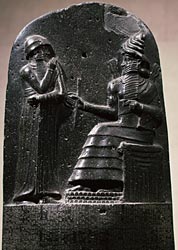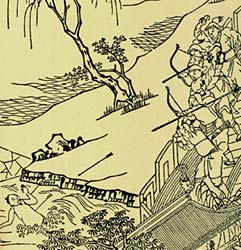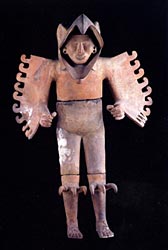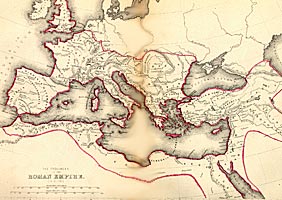 There is considerable documentary evidence that banditry was a commonplace phenomenon in the ancient world. For example, in the prologue to the Code of Hammurabi, this powerful ruler is described in the first person as "the exalted prince, who feared God, to bring about the rule of righteousness in the land, to destroy the wicked and the evil-doers; so that the strong should not harm the weak; so that I should rule over the black-headed people like Shamash, and enlighten the land, to further the well-being of mankind." The prologue then provides a long list of attributes and feats of the "exalted prince," Hammurabi, who is described in the following manner:"Potent, who penetrated the secret cave of the bandits." This description is followed by "saved the inhabitants of Malka from misfortune, and fixed their home fast in wealth," which may or may not be a continuation of the feat related to the bandit cave.
There is considerable documentary evidence that banditry was a commonplace phenomenon in the ancient world. For example, in the prologue to the Code of Hammurabi, this powerful ruler is described in the first person as "the exalted prince, who feared God, to bring about the rule of righteousness in the land, to destroy the wicked and the evil-doers; so that the strong should not harm the weak; so that I should rule over the black-headed people like Shamash, and enlighten the land, to further the well-being of mankind." The prologue then provides a long list of attributes and feats of the "exalted prince," Hammurabi, who is described in the following manner:"Potent, who penetrated the secret cave of the bandits." This description is followed by "saved the inhabitants of Malka from misfortune, and fixed their home fast in wealth," which may or may not be a continuation of the feat related to the bandit cave.
In China, bandits were as common as in the West, and bandit-heroes are the subject of one of the four most famous works of classical Chinese literature,  Outlaws of the Marsh (a new English-language edition appeared in 2001). This important fourteenth-century work, loosely based on an actual gang of twelfth-century robbers, was also translated by Pearl S. Buck as All Men Are Brothers, which she discusses in the context of the development of the Chinese novel in her Nobel Prize lecture (December 12, 1938).
Outlaws of the Marsh (a new English-language edition appeared in 2001). This important fourteenth-century work, loosely based on an actual gang of twelfth-century robbers, was also translated by Pearl S. Buck as All Men Are Brothers, which she discusses in the context of the development of the Chinese novel in her Nobel Prize lecture (December 12, 1938).
Berdan (1999) has reviewed criminality in pre-Hispanic Aztec society using both Amerindian texts such as theMendoza Codex and theFlorentine Codex and accounts from Spanish sources penned shortly after the conquest of Mexico, including those of Cortés, Díaz del Castillo, Durán, and Motolinía. In his review of criminal acts ranging from the foraging of cacao beans (the smallest denomination of pre-Hispanic currency in addition to an exclusive beverage), through ambushes by highwaymen of tax collectors and merchants and defalcation on the part of those very tax collectors and  merchants, to spying and treason by individuals within the Triple Alliance generally known as the Aztec empire (Tenochtitlán, Texcoco, and Tlacopán), as well as with respect to the relationships between the Triple Alliance and other city-states, Berdan permits us to recognize numerous criminal circumstances analogous to those of the Graeco-Roman world despite the vastly different cultural environment of pre-Hispanic Mesoamerica.
merchants, to spying and treason by individuals within the Triple Alliance generally known as the Aztec empire (Tenochtitlán, Texcoco, and Tlacopán), as well as with respect to the relationships between the Triple Alliance and other city-states, Berdan permits us to recognize numerous criminal circumstances analogous to those of the Graeco-Roman world despite the vastly different cultural environment of pre-Hispanic Mesoamerica.
The Bible has various references to bandits and thieves, including, of course, the narrative of the Good Thief in relationship to the Passion of Christ. In Luke 23:33-43 it is stated about Christ:
. . . they crucified him along with two bandits, one on the right and the other on the left. . . . One of the bandits hanging there cursed him. "Are you not the Christ?" he said. "Then save yourself and us as well." But the other one spoke up and reproved him. "Have you no fear of God at all?" he said. "You received the same sentence as he did, but in our case we deserved it, we are paying for what we did. But this man has done nothing wrong."
"Jesus," he said. "Remember me when you enter into your kingdom." "Yes, I promise you," Jesus replied, "today you will be with me in Paradise."
The references above contain within them suggestions of an important paradoxical phenomenon that Saint Augustine succinctly summarizes in his Civitas Dei (City of God,4.4):
Take away justice, then, and what are governments but great bandit bands? And after all, what are bands of bandits but small states? The gang itself consists of men, it is directed by the authority of the chief, it is bound together by a pact of mutual support, and the loot is divided in accordance with an agreed law. If, as a result of the recruitment of desperadoes, this evil grows to such an extent that it takes control of a territory, establishes bases, occupies cities and subjugates peoples, then it assumes the name of a government, the more openly because this is now plainly applicable: not because the robbers have renounced their rapacity, but because they are no longer at risk of punishment.St. Augustine goes on to illustrate this paradox with the reply that a captured pirate made to Alexander the Great, which Augustine considered apposite and legitimate. When the ruler asked the man how he could justify making the sea a dangerous place, he answered with defiant outspokenness, "In exactly the way that you
 justify doing the same to the whole world. But because I do it with a single paltry ship, I am called a robber; while you do it with a large navy, and are called an emperor."
justify doing the same to the whole world. But because I do it with a single paltry ship, I am called a robber; while you do it with a large navy, and are called an emperor."
The Roman Empire (approximately BC 100–AD 350) has been the period most studied by social bandit historians, spurred by the ground-breaking work of Eric Hobsbawm, either in favor of, in opposition to, or as a point of departure from this historian’s work. In addition to Hobsbawm from a pioneering and theoretical point of view, Anton Blok, Thomas Grünewald, P. A. Mackay, Brent D. Shaw, and Anton J. L. Van Hooff, among others, have produced significant studies of banditry in the Roman Empire.